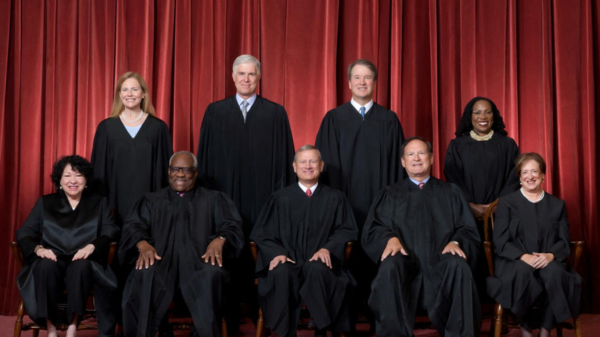A U.S. Supreme Court ruling will keep the abortion pill available, with the justices declining to decide the merits of the case.
In FDA v. Alliance for Hippocratic Medicine, the high court ruled unanimously the plaintiffs lacked standing, meaning they did not show an injury to themselves, on June 13.
The court did not rule on whether the U.S. Food and Drug Administration (FDA) acted improperly in its 2000 approval of mifepristone, the first of a two-pill series pregnant women take to induce chemical abortions, or expanding access to the drug, most recently during the pandemic.
The plaintiffs included the Alliance for Hippocratic Medicine, a group of pro-life medical associations, and four individual physicians. The plaintiffs were represented by the Alliance Defending Freedom (ADF), a legal group.
Procedural Decision
Erik Baptist, a senior counsel at ADF who worked on the case, called the court’s opinion a procedural decision.
“What the Supreme Court decided was that our clients didn’t show sufficient injuries where we were not allowed to bring such a case against the FDA,” said Baptist.
“The court did not rule on the merits of our case or whether what the FDA did was reckless and unlawful,” said Baptist. “That’s an issue and a question that’s going to be answered later.”
Conscience Injury
Baptist and his team had alleged multiple injuries, including a “conscience injury” to the doctors.
“FDA’s own label for the drugs says one in 25 women will end up in the emergency room,” said Baptist. “When the FDA was pushed to require those prescribers to treat women for those complications, the FDA’s response was to direct women to America’s emergency rooms and hospitals, where our doctors, obstetrician-gynecologists, work and care for and treat women.”
Baptist says his team cited examples of how the FDA’s actions have put women into dangerous situations “where they may require surgical intervention which would lead to the end of the life of their baby or make our doctors feel complicit in elective chemical abortions in general.”
Additionally, the plaintiffs argued the FDA “expressly conscripted” the pro-life doctors away from helping deliver babies and required them to “help the women who are suffering from the complications from these elective chemical abortions,” said Baptist.
Environmental Precedents
The ADF team relied on decades-long precedents on environmental law to argue the plaintiffs had standing. Baptist said the Supreme Court has decades-long precedents recognizing emotional and psychological harm as sufficient injury to meet standing requirements, citing cases related to the Endangered Species Act and the Keystone Pipeline.
“We cited the equivalent argument, saying that our doctors, again, are heartbroken and hurt emotionally when they see women harmed by chemical abortion drugs and have to experience the heartbreak of watching unborn life being taken away,” Baptist said.
“Someone’s heartache over an endangered species, such as a beetle or a whale—we value human life over all those,” said Baptist. “That’s to me equal if not more reason [for standing].
Standing Double Standard
The Supreme Court did not respond to the ADF’s argument for precedents on injuries to conscience, says Baptist.
“It was in our brief,” said Baptist. “It was there. I can’t explain why the court did not address it.”
In a blog post at The Federalist Society website before the decision was released, Baptist said the Supreme Court had only three options: overrule precedent, uphold precedent, or create a double standard.
“The fourth option, which I did not write about, was just to ignore this argument,” said Baptist. “And so, it didn’t affect the precedent in any capacity whatsoever.”
Baptist says the ADF is discussing next steps with its clients.
“I think the court took pains to make this decision about only this particular case and these particular plaintiffs and nobody else,” said Baptist.
‘Inherently Dangerous Drugs’
In a 2023 interview with Health Care News, Katie Daniel, an attorney and state policy director at Susan B. Anthony Pro-Life America, said the FDA required protocols designed for dangerous drugs in approving mifepristone and misoprostol, the second drug used in chemical abortions.
“The FDA originally approved the abortion pill combo in 2000 under rules that are applied to inherently dangerous drugs,” said Daniel. “FDA knew it could not get them through the normal protocols, and so it had to push them through a protocol called Subpart H, which was originally created for AIDS medications and cancer drugs—drugs that have inherent, severe side effects, drugs that treat life-threatening illnesses.”
The FDA initially required certification of prescribing physicians, time limits on when the drug could be dispensed, complication reporting, and in-person visits, but subsequently liberalized or eliminated those restrictions.
“Additionally, it reclassified pregnancy—a normal pregnancy, not a high-risk pregnancy—as a life-threatening illness, just to get it through the process,” said Daniel.
A March 2021 report by The Heritage Foundation documented the safety concerns of abortion pills; as of 2018, there were 24 deaths associated with the pill and more than 4,000 adverse incidents.
State Action
Several states restricted abortion after the Supreme Court overturned Roe v. Wade, which in 1973 legalized abortion in every state in the case of Dobbs v. Jackson Women’s Health in 2022.
A separate lawsuit by Kansas, Idaho, and Missouri is challenging the 2016 and 2021 FDA decisions to remove requirements for in-person doctor visits and to allow mail-order abortions.
Several blue states are thwarting abortion bans in other states by allowing their licensed doctors to prescribe abortion pills via telemedicine and shielding the doctors from prosecution.
Harry Painter (harry@harrypainter.com) writes from Oklahoma.
Internet Info:
“23-235 FDA v. Alliance for Hippocratic Medicine (06/13/2024),” SupremeCourt.Gov, Jun. 13, 2024: https://www.supremecourt.gov/opinions/23pdf/23-235_n7ip.pdf
“Alliance for Hippocratic Medicine et al v. U.S. Food and Drug Administration et al, No. 2:2022cv00223 – Document 137 (N.D. Tex. 2023),” Justia.com, April 7, 2023: https://law.justia.com/cases/federal/district-courts/texas/txndce/2:2022cv00223/370067/137/
This article was revised on July 9, 2024, to include additional information.





















